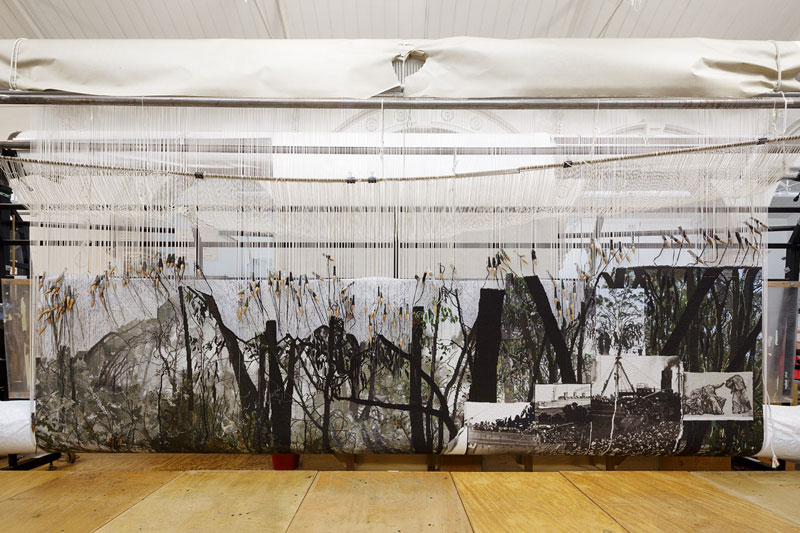




In 2017 a major new tapestry, Morning Star was commissioned for the new Sir John Monash Centre (SJMC) in Villers-Bretonneux, France. Morning Star was designed by prominent Australian artists Lyndell Brown and Charles Green.
The tapestry was generously supported by the Tapestry Foundation of Australia, Australian Hotels Association, ANZAC Centenary Arts and Culture Fund, Marjorie M. Kingston Charitable Trust, Calvert-Jones Family, Anne and Mark Robertson OAM, Baillieu Myer AC and Sarah Myer, Yulgilbar Foundation, Chasam Foundation and the Myer Foundation.
The SJMC was designed by Cox Architects and Convergence Associates to create an evocative, emotional, informative and educational experience for visitors. The Centre will provide a lasting legacy in perpetuity commemorating the 46,000 Australian lives lost in the battles of the Western Front in World War 1 and will commemorate the Centenary of ANZAC.
Of the tapestries lasting contribution and symbolism, Brown and Green noted:
“Just as the SJMC provides both Australian and non-Australian visitors with an understanding of the impact of Australia’s involvement on the Western Front through an engagement with the places in which the Australians fought and the experiences of those who were there, so this tapestry aims to communicate to non-Australians and to Australian pilgrims an understanding of the places for which the Australians fought and the imaginary spaces that they carried with them.
The tapestry seeks to evoke the experience of arrival at a war, and in particular of Australians at the Western Front. With them on their arrival were their memories of Australia and their departure from home. These are the subjects of the tapestry. This tapestry aims to evoke the soldiers’ pathway from home to the Front, and emphasizes the incongruity between the Australia that they imagined as they journeyed further towards the Front. It seems to us that it is absolutely essential, first, to evoke a mental place of Australian freedom and clear light; and, second, to evoke the sea-borne passage towards the soldiers’ arrival at the Front. The tapestry emphasises the disjunction between the terrible experiences that the museum describes rather than repeats them.
There are two personal contexts that we offer to illuminate our work. Charles Green’s grandfather served as an Australian soldier on the Western Front. He was gassed and lived the rest of his life as an invalid, as a deeply disturbed shadow. Although he died decades before Green was born, that WW1 tragedy was very present in his family and especially with his grandmother, by then a war widow. And interestingly, she spoke often about the soldiers’ love of Sir John Monash, describing him to us with great devotion. Second, in 2007 we were Australia’s Official War Artists, deployed into Iraq and Afghanistan for a period longer than any War Artist since the program was reinstituted in 1996, and during those deployments we spent all our time amongst soldiers on active duty, surprised by their complete support for war artists and humbled by their sense of public service. Ever since, our art has been dominated by reflections on the aftermath of war and the survival of the past into the present."
The overall image shows dawn light, during winter, illuminating a pathway through eucalypt trees and bush towards sunlight. The inset images are a combination of departures to war by ship from Australia, punctuated by visual comments (snaps of these young men, those who were about to enlist). We have deliberately chosen to make these images almost monochromatic—very tonal with a subtle but definite minimum of colour—as the weavers at ATW have repeatedly demonstrated enormous, subtle virtuosity in translating very tonal images with precise grey ranges into tapestry.
Morning Star was unveiled at the official opening of the SJMC in April, 2018.
Lyndell Brown and Charles Green are represented by Arc One Gallery.